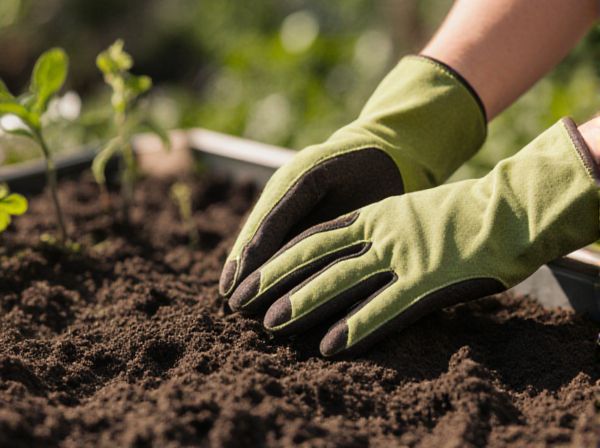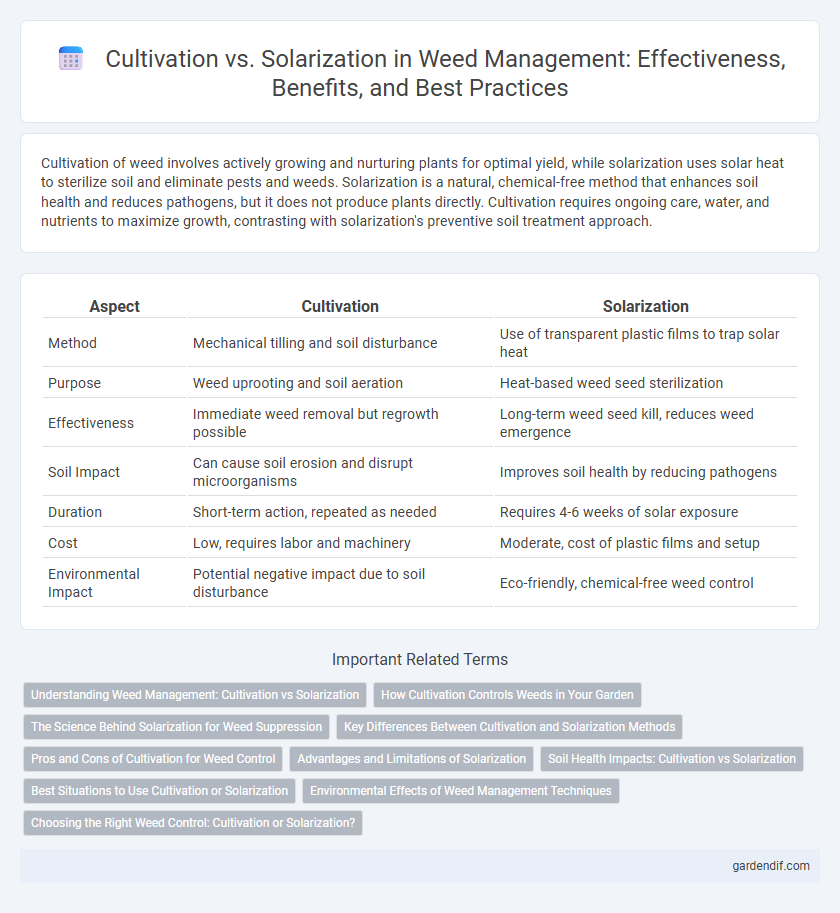
Cultivation vs Solarization Illustration
Cultivation of weed involves actively growing and nurturing plants for optimal yield, while solarization uses solar heat to sterilize soil and eliminate pests and weeds. Solarization is a natural, chemical-free method that enhances soil health and reduces pathogens, but it does not produce plants directly. Cultivation requires ongoing care, water, and nutrients to maximize growth, contrasting with solarization's preventive soil treatment approach.
Table of Comparison
| Aspect | Cultivation | Solarization |
|---|---|---|
| Method | Mechanical tilling and soil disturbance | Use of transparent plastic films to trap solar heat |
| Purpose | Weed uprooting and soil aeration | Heat-based weed seed sterilization |
| Effectiveness | Immediate weed removal but regrowth possible | Long-term weed seed kill, reduces weed emergence |
| Soil Impact | Can cause soil erosion and disrupt microorganisms | Improves soil health by reducing pathogens |
| Duration | Short-term action, repeated as needed | Requires 4-6 weeks of solar exposure |
| Cost | Low, requires labor and machinery | Moderate, cost of plastic films and setup |
| Environmental Impact | Potential negative impact due to soil disturbance | Eco-friendly, chemical-free weed control |
Understanding Weed Management: Cultivation vs Solarization
Weed management techniques like cultivation and solarization offer distinct advantages in controlling invasive species. Cultivation physically disrupts weed growth through tilling or hoeing, promoting soil aeration and immediate removal of unwanted plants, whereas solarization uses solar heat trapped under clear plastic to kill weed seeds and pathogens in the topsoil. Selecting between cultivation and solarization depends on soil health goals, weed species targeted, and environmental conditions influencing effectiveness and sustainability.
How Cultivation Controls Weeds in Your Garden
Cultivation controls weeds in your garden by physically disturbing the soil to uproot or bury weed seedlings, preventing their growth and spread. Regular cultivation disrupts the weed lifecycle, reducing competition for nutrients, water, and light with desired plants. This method is especially effective for annual weeds, maintaining a cleaner and healthier garden environment.
The Science Behind Solarization for Weed Suppression
Solarization utilizes solar energy to raise soil temperatures to levels that inhibit weed seed germination and kill soil-borne pathogens, creating a hostile environment for weed proliferation. This method involves covering moist soil with clear plastic for several weeks, trapping heat and effectively reducing weed seed viability through thermal inactivation. Studies show solarization can decrease weed seed banks by up to 90%, providing an eco-friendly alternative to chemical herbicides in cannabis cultivation.
Key Differences Between Cultivation and Solarization Methods
Cultivation involves actively growing weed plants through soil preparation, planting, watering, and maintenance, ensuring optimal growth conditions and yield. Solarization uses solar heat to sterilize soil by covering it with transparent plastic, effectively eliminating weed seeds and pathogens without chemical inputs. The key difference lies in cultivation promoting weed growth, while solarization aims to suppress or eradicate weed populations through soil treatment.
Pros and Cons of Cultivation for Weed Control
Cultivation for weed control physically disrupts weed growth by uprooting plants and disturbing the soil, making it effective for managing annual weeds. It improves soil aeration and promotes crop health but can lead to soil erosion and disruption of beneficial soil organisms if overused. Cultivation requires labor and equipment, potentially increasing production costs and fuel consumption.
Advantages and Limitations of Solarization
Solarization offers the advantage of naturally controlling weed seeds and soil-borne pathogens through solar heat, reducing the need for chemical herbicides and promoting organic cultivation. However, its effectiveness depends heavily on climatic conditions, requiring high temperatures and prolonged exposure periods that may not be feasible in cooler or cloudy regions. Limiting factors also include the time-consuming process and potential disruption of beneficial soil microorganisms, making it less practical for rapid or large-scale weed management compared to conventional cultivation methods.
Soil Health Impacts: Cultivation vs Solarization
Cultivation disrupts soil structure and microbial communities by frequent tilling, which can lead to erosion and reduced organic matter content, negatively impacting soil health. Solarization uses solar energy to heat the soil, effectively reducing weed seeds and pathogens while preserving beneficial soil organisms and improving nutrient availability. Compared to cultivation, solarization offers a sustainable method for weed control that enhances soil biological activity and maintains long-term fertility.
Best Situations to Use Cultivation or Solarization
Cultivation is best suited for large-scale outdoor weed control where mechanical disruption can effectively manage mature plants and prevent weed seed formation. Solarization excels in small garden beds, greenhouses, or areas with high sunlight exposure, using clear plastic to trap heat and kill weed seeds and pathogens in the soil. For long-term weed suppression, combining cultivation for immediate control with solarization for soil sterilization offers optimal results.
Environmental Effects of Weed Management Techniques
Cultivation disrupts soil structure and increases erosion risk, leading to potential loss of organic matter and habitat for beneficial soil microorganisms. Solarization uses solar heat to control weeds, reducing chemical inputs but may temporarily increase soil temperature, affecting microbial communities and nutrient cycling. Choosing between cultivation and solarization requires balancing immediate weed suppression benefits with long-term soil health and ecosystem sustainability.
Choosing the Right Weed Control: Cultivation or Solarization?
Choosing the right weed control method depends on soil type, crop sensitivity, and environmental conditions. Cultivation mechanically disrupts weed growth, offering immediate results but can lead to soil erosion and disturbance of beneficial organisms. Solarization uses solar heat to sterilize soil, effectively controlling weed seeds and pathogens in warm climates, with the added benefit of improving soil health over time.
Cultivation vs Solarization Infographic

 gardendif.com
gardendif.com